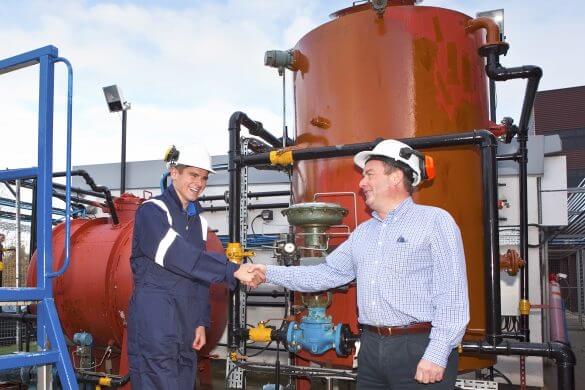San Antonio earlier this month joined Austin and two dozen other major American cities in adopting a climate action plan aimed at operating city government and city-owned utilities and transportation systems entirely without fossil fuels by 2050.
The goals highlighted in the Climate Action & Adaptation Plan are broad and far-reaching: reducing greenhouse gas emissions to reduce the impact of climate change, enhance the quality of life, and ensure the health and well being of the most vulnerable populations in San Antonio.
If anything, Mayor Ron Nirenberg and the nine (of 10) council members who voted for the plan believe it isn’t aggressive enough. They made concessions to the city’s municipally-owned utility, CPS Energy, and to a business community that has largely disowned the plan.
“We declare that we will not be bystanders,” Nirenberg announced after voting for the plan. “In no simpler terms, here and around the world, we are in a climate emergency.”
Calls to staff members for Nirenberg and to council member Ana Sandoval, one of the chief proponents of the plan, were not returned.
What the plan doesn’t do is tell San Antonians how, exactly, the city intends to attain a carbon-free future. Nor does it say what it will cost to transition from the currently much less expensive coal and natural gas to renewable sources like solar- and wind-generated electricity.
“Proven technological solutions may not yet be available to meet long-term GHG (greenhouse gas) reduction goals,” is the explanation for why the plan doesn’t include a map to 2050. And because the technology isn’t yet known, the study says, “in many cases, good data does not yet exist,” to estimate what the costs will be.
Such an open-ended plan, like the one passed in Austin in 2015, allows San Antonio to pick and choose the technologies that will best help it achieve its environmental goals. But it also allows utility officials and the city council to gamble on renewable energy in a fossil fuel-dominated energy market. Similar gambles cost utility customers $1 billion in Austin and resulted in a multi-million dollar rate increase spiral in Georgetown.
The transition to more expensive energy might also force a progressive mayor and city council to forego pet programs. Net revenue from energy sales over a hot summer allowed CPS Energy to add nearly $8 million more to the city budget for next year funding 23 projects, including a property tax exemption for homeowners, eviction assistance for low-income families, and funding for a proposed Mexican-American civil rights institute, according to CPS and city-data.
Clayton Perry, the lone city council member who voted against the climate plan, said CPS Energy officials have convinced him they will not move ahead too quickly or burden utility ratepayers with onerous costs.
Perry, like many other opponents, is upset that the council would take an action on behalf of customers and taxpayers without giving them some idea of what they are getting and what they will have to pay for it.
There will be tremendous pressure to move quickly, regardless of cost, from environmental activist groups that pushed the climate plan in the first place, the mayor who first ran for his office on the issue, and the council majority, Perry said.
“The people pushing this don’t really care about what it’s going to cost,” Perry told The Texas Monitor this week. “Some of their ideas are totally off the wall, like shutting down coal plants now that aren’t paid for and [replacing them] with renewable technology that doesn’t exist. It’s crazy.”
Doug Melnick, chief sustainability officer for the city, told The Texas Monitor that all proposed technologies and their expenses will be vetted by the utility and considered and voted on by the city’s elected officials.
Some American cities began developing plans to reduce or eliminate greenhouse gas emissions in their operations in advance of the United Nations’ Paris Agreement ratified at the end of 2015. Donald Trump announced shortly after his inauguration as president that the United States would pull out of the agreement by 2020.
The issue of cities following the Paris Agreement has largely divided along political lines. All but two of the major 26 cities with climate plans have Democratic mayors. In addition to San Antonio and Austin, Dallas and Houston, headed by Democrats, are in the final stages of preparing climate plans for council approval.
“The San Antonio City Council passed a resolution in support of the Paris Climate agreement in 2017,” Melnick said. “San Antonio’s first climate plan meets that commitment and prepares the city for projected changes in our weather patterns that will affect infrastructure investments, municipal operations and services. As such, it prioritizes transportation choices, clean and secure energy resources and emergency preparedness.”
To get there, the plan lays out six broad goals. The first is to increase the use of carbon-free or renewable energy sources to power all municipal buildings and, second, reduce the overall energy use in those buildings. This energy use is the biggest source of the city’s greenhouse gas emissions.
The third goal is to reduce the amount of energy used by all municipal transportation methods, the source of more than a third of the city’s greenhouse gas emissions. According to the plan the city will promote electric vehicles, encourage reducing the miles traveled by gas-powered vehicles and promote mass transit.
The fourth is to accelerate measures already in place to reduce overall consumption, reduce waste and enhance recycling. The breakdown of waste in landfills is another source of greenhouse gases.
The fifth goal is to promote biodiversity and natural ecosystems that absorb emissions. And last is to use “policy, training, incentives and financing” to encourage residents and business owners to make changes in their behavior and to take advantage of new technology to reduce greenhouse gases on their own, according to the plan.
The plan does not, however, prepare businesses for the cost of CPS Energy transitioning to higher cost electricity, which could be a result of the plan, business leaders in San Antonio have said.
When asked, Melnick said, “The business community does not oppose the plan but wanted to make sure there was a thoughtful implementation process that includes continued engagement and economic analysis, which the plan includes.”
David Fry, director of administration for Cox Manufacturing Co., told the council a different story on the night of its vote. “There was no true buy-in from the business community. There is none now.”
Rey Chavez, a spokesman for the San Antonio Manufacturer’s Association, repeatedly lauded the “aspirational goals” of a cleaner environment included in the plan. But no business would develop any ambitious plan without outlining what was needed to implement it and how much it might cost, Chavez said.
Chavez is less confident than Perry that CPS Energy will resist paying whatever it costs to meet the climate plan goals, because he said utility staff will be under tremendous pressure to satisfy the city’s elected officials.
“It’s my gut feeling that they [the mayor and council] have an agenda and they are going to make it happen, regardless,” Chavez said. “They’ll say, ‘Yeah, we’ll have a public discussion, but we’re going to go forward with this.’ ”
On the night of the plan’s passage, Olufemi Osidele, co-chair of the steering committee for the plan, told the council they needed to pass it despite its shortcomings. Osidele is a consultant for a Houston company that specializes in helping companies transition to renewable energy.
“So, is the CAAP [Climate Action & Adaptation Plan] incomplete? Yes,” Osidele told the council. “Could it be done better? Yes. But are these sufficient reasons not to adopt the CAAP today? Absolutely not. That would be throwing out the baby with the bathwater.”
Osidele did not respond to an email requesting comment.
This article was originally published on The Texas Monitor.








